|
Mathematics
- 1997 ( I.C.S.E)
You are on Answers 1 to 9
Q1. A person invests Rs.
5,600 at 14% p.a. compound interest for 2 years. Calculate :
(1) The interest for the 1st year ;
(2) The amount at the end of the 1st year
(3) The interest for 2nd year, correct to the nearest Rs.
|
Ans.P = Rs 5600
I = 14%
(i) Amount = P(1+R/100)n
= Rs 5600(114/100)
= Rs 6384
C.I = A-P = Rs (6384 - 5600 )= Rs 784.
(ii) Amount at the end of Ist year = 6384
(iii) A= 5600 (114/100)2=7278
I= A - P = 7278-5600
=1678
Then I for the 2 nd yr
will be I = I2
- I1
=1678 - 784
=4894 |
|
Q2 Lessons on
loss, profit and discount has been omitted from the syllabus w.e.f. year
2000
|
|
Q3. On a map drawn to a
scale of 1:250000 a triangular plot of land has the following
measurements:
AB = 3 cm, BC = 4 cm, Ð ABC = 90°. Calculate :
(1) the actual length of AB in km;
(2) the area of the plot in sq.km.
|
Ans. (i) AB = 3 cm.
= .00003Km.
Scale 1:250000
AB = 7.5 Km.
(ii) AB = 7.5 Km.
Scale 1:250000
BC = 4 cm. = 10 Km.
Area = 1/2xbxh
= 1/2x7.5x10 = 37.5 Km2 |
|
Q4. Part of a
geometrical figure is given in each of the diagrams below.
Complete the figure so that the line AB in each case is a line of symmetry
of the completed figure.
Give also the geometrical name for the completed figure.
Recognizable free hand sketches would be awarded full marks.
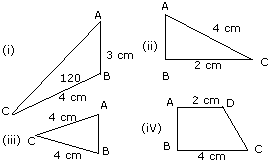
|
| Ans.

|
|
Q5. A Bucket is raised
from a well by means of a rope which is wound round a wheel of diameter 77
cm. Given that the bucket ascends in 1 minute 28 seconds with a uniform
speed of 1.1 m/s calculate the number of complete revolutions the wheel
makes in raising the bucket .Take p to be 22/7.
|
Ans. T = 1 minute 28
second = 88 second
Speed = 1.1 m/s
Distance = SxT = 88x 1.1 = 96.8 m
Circumference = 2 p r = 242 cm. = 2.42 m. where p is actually
n(2pr) = Distance
n = Distance / 2p r = 40 revolutions. |
|
Q6.Ruler and compasses
only may be used in this question. All construction lines and arcs must be
clearly shown, and be of sufficient length and clarity to permit
assessment .
(i) Construct triangle ABC, in which BC = 8 cm, AB = 5 cm, angle ABC = 60o
;
(ii) Construct the locus of points inside the triangle which are
equidistant from BA and BC ;
(iii) Construct the locus of point inside the triangle which are
equidistant from B and C ;
(iV) Marks as P, the point which is equidistant from AB,BC and also
equidistant from B and C ;
(V) Measure and record the length of PB.
|
Ans. (i)
Steps of const:
(1) Draw line BC 8cm.
(2) Draw angle XBC = 600.
(3) As B as a centre and radius of 5cm mark a point A on the line
XB.
(4) Join AC.
(5) ABC is the required triangle.
(ii) Hint : The point where the angle bisector of the angle A
and angle B meets is the locus point.
(iii) Hint : The point where the angle bisector of the angle B
and angle C meets is the locus point.
(iv) Hint: The point of contact of the angle bisectors of all the
angles is the required point P |
|
Q7.(i) point P (a,b) is
reflected in the x axis to P'(5,-2). Write down the value of a and b.
(ii)P'' is the image of P when reflected in the y axis. Write down the
coordinates of P''.
(iii)Name a single transformation that maps P' to P''.
|
Ans.(i) The value of a = 5, b =
2
(ii) The coordinates of P'' (a,b)
(iii) The single transformations of P' (5,-2) is P" (-5,2) .i.e. both
co-ordinates change their sign . |
|
Q8.
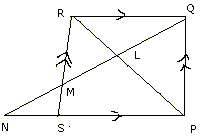
In the above figure, PQRS is a parallelogram ; PQ = 16 cm, QR = 10 cm. L
is a point on PR such that RL : LP = 2:3. QL produced meets RS at M and PS
produced meets at N.
(i) Prove that triangle RLQ is similar to triangle PLN. Hence find PN.
(ii) Name a triangle similar to triangle RLM. Evaluate RM as a fraction.
|
Ans.(i) In the triangle RLQ and
triangle PLN
angle RLQ = angle PLN
angle LRQ = angle LPN
therefore triangle RLQ ~ triangle PLN (AA)
RQ/PN=RL/LP=2x/3x
=10/PN = 2/3 = PN = 15cm
(ii) triangle RLM ~ triangle PLQ (AA)
RM = LM = RL
PQ QL
LP
RM = 2x
16 3x
RM = 32/3 cm. |
|
Q9.(a) State whether the
following statements are TRUE or FALSE.
(i) If a b, then a-cb-c.
(ii) f a<b,then ac<bc.
(iii) If ab,then a/c b/c.
(iV) If a-c < b-d, then a+d < b+c.
where a,b,c,d are real number , c ¹ 0.
(b) Evaluate without using table :
|
( |
2 cos 60o
|
-2 sin 30o |
)
( |
cot 45o |
cosec 30o |
) |
| -tan 45o |
cos 0o |
sec 60o |
sin 90o |
|
|
Ans.(a) (i) True
(ii) True
(iii) True
(iii) True
(iv) True
(b) By putting the values and solving it:

|
|
Q10. (a)
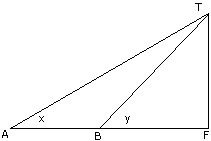
In the above figure, not drawn to sale TF as a tower . The elevation
of T from A is x , where tan x=2/5 and AF=200m. The elevation of T from B,
where AB=80m, is y. Calculate :
(i) The height of a tower TF ;
(ii) The angle y,correct to the nearest degree.
(b.) Ruler and compasses only may be used in this question.All
construction lines and arcs must be clearly shown,and be of sufficient
length and clarity to permit assessment.
(i) Construct triangle ABC, in which AB=9 cm, BC= 10 cm and angle ABC=45o
;
(ii) Draw a circle, with centre A and radius 2.5 cm. Let it meet AB at D.
(iii) Construct a circle to touch the circle with centre A externally at D
and also to touch the line BC.
(c) Calculate the distance between A(7,3) and B on the x-axis whose
abscissa is 11.
|
Ans. (i) In triangle AFT
TF/AF = tan x = 2/5
TF/200 = 2/5
TF = 400/5 = 80 m
(ii) BF = AF - AB = 200- 80 = 120
tan y = 80/120 = 2/3 = 0.667
y = tan-1 .667 = 33.70
(b)(1) Draw the line BC = 10 cm
(2)At B make an angle XBC = 450
(3) Taking B as centre and radius of 9 cm mark a point A.
(4) Join AC
ABC is the required triangle
(ii) Hint : taking A as centre and radius 2.5 cm. Draw a circle it
intersect AB at the point D.
(c)

AB = Ö((7-11)2+(3)2)
=Ö(16+9) =5 units.
|
|
Q11. (A.)
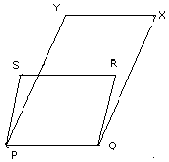
In the above figure ,PQRS and PQXY are
parallelograms.
(i) Prove that SX ans RY bisect each other;
(ii)If SX=RY, prove that angle RSY =90o.
(B.) Car A travels x Km. for every litre of petrol used by car B travels
(x+5) Km. for every litres of petrol.
(i) Write down the number of litres of petrol used by car A and car B in
covering a distance of 400 Kms individually.
(ii) If car A uses 4 litres of a petrol more than car B in covering
the 400 Km. write down an equation in x and solve it to determine the
number of litres of petrol used by car B for the journey.
|
Ans.(i)

const : join S Y or X R , join Y R and X S
proof : P Q = S R (PQRS is parallelogram)
P Q ½½ S R
P Q = Y X (PQXY is a parallelogram)
P Q ½½ Y X
therefore from these results SRXY is parallelogram
therefore SX bisect RY because diagonal of parallelogram bisect each other
(ii) if SX = RY
the diagonals of parallelogram are equal only in two cases either it is
rectangle or square in both the cases the angles are 900
therefore angle RSY = 900
(b)(i) No of litres of petrol used by car A = 400/X
No of litres of petrol used by car B = 400/(X + 5)
(ii) 400/X - 400/(X + 5) = 4
solving this equation for X
X = 20 therefore consumption of car A = 400/20 = 20
consumption of car B 400/25 = 16 |
|
Q12. (A.) The contents
of 100 match boxes were checked to determine the number of matches they
contained.
No of matches : 35
36 37 38
39 40 41
No of boxes : 6
10 18
25 21 12
8
(i) Calculate ,correct ot one decimal place, the number of matches per box
;
(ii) Determine how many extra matches would have to be added to the total
contents of the 100 boxes to bring mean up to the exactly 39 matches.
(B.) Use a graph paper for this question.
Draw the graph of x + y + 2 = 0 and 3x - 4y =15 on the same
axes. Use 2 cm = 1 unit in both cases only three points per line.
Write down the coordinates of the point of intersection of lines.
|
Ans.(a) Mean = S fixi/S
fi
|
xi
|
fi
|
xifi
|
|
35
|
6
|
210
|
|
36
|
10
|
360
|
|
37
|
18
|
666
|
|
38
|
25
|
950
|
|
39
|
21
|
819
|
|
40
|
12
|
480
|
|
41
|
8
|
328
|
|
|
S fi = 100
|
S fixi
= 3813
|
Mean = 3813/100 = 38.13
(ii) Mean = sum of observation/No. of observation
39 = SUM/100
SUM = 39 x 100 = 3900
so extra matches required = 3900 - 3813 = 87
(b) We are solving this and try yourself on graph
X + Y + 2 = 0
3X - 4Y = 15
solving first equation
x = -y -2
The pt. of intersection will be (1,-3)
solving second equation
x = (15 + 4y)/3
|
|
Q 13.(a) Attempt this
question on a graph paper.
The table below shows the distribution of marks gained by a group of 400
students in an examination :
marks less than 10 20 30
40 50 60 70
80 90 100
no. of students 5 10
30 60 105 180 270
355 390 400
Using a scale of 2 cm to represent 10 marks and 2 cm to represent 50
students, plot these values and draw a smooth curve through the points.
Estimate from the graph : (i) the median mark (ii)
the quartile marks.
|
| Ans.
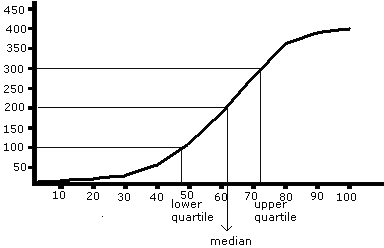
|
Q14. (A.) A
lady holds 1800 shares each of Rs. 100 of a company that pays 15% dividend
annually. Calculate her annual dividend.
If she has bought these shares at 40 % premium what % return does
she get on her investment ? Give your answer to the nearest integer.
(B.) A cylindrical can whose base is horizontal and of radius
3.5 cm contains sufficient water so that when a sphere is placed in the
can the water just covers the sphere. Given that the sphere just fits into
the can. Calculate
(i) the total surface area of the can in contact with water when the
sphere is in it.
(ii) the depth of water in the can before the sphere was put into the can.
Take p to be 22/7 and give your answer as proper fraction. |
| Ans.(A)
Calculation for annual dividend :
1800 shares @ Rs 100 each (1800 x 100) = 180000
Rate of dividend is 15 %
so amount of dividend 180000 X 15/100 = 27000
calculation of percentage of return on investment :
amount of investment 1800 x 140 = 252000
income = 27000
then return on investment 27000/252000 x 100 = 10.71 % or say 11 %
(B)

Surface area of the can in contact with
water = Surface area of can - Surface area of sphere
S = 2prc(rc + h) - 4pr2
rc = 3.5, h = 7,
r = 3.5
S = 385 cm2
B) (ii) Volume of water = volume of can - volume of sphere
pr2h = pr2h - 4/3pr3
By putting the value and solving it
h = 2.33 cm
|
|
Q 15. (a) (i) The line
4x - 3y + 12 = 0 meets the x - axis at A . Write the coordinates of A.
(ii) Determine the equation of the line passing through A and
perpendicular to 4x - 3y + 12 = 0
(b)
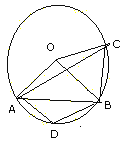
In the figure given above A,D, B, C are
four points on the circumference of a circle with centre O . Arc AB = 2
(arc BC) and angle AOB = 108o. Calculate in degrees :
(i) angle ACB,
(ii) Angle CAB
(iii) angle ADB.
justify your calculation.
|
|
Ans. (a) (i) 4x - 3y +12 = 0
for the coordinates of A (y = 0)
therefore 4x = 3y - 12
x = -3
A = (-3, 0)
(ii) Given line 4x - 3y + 12 = 0
given coordinate of A = (-3, 0)
3y = 4x + 12
y = (4/3)x + 12
slope of 4x - 3y + 12 = 0
m1 = (4/3)
equation of a required line is
(y - 0) = -3/4(x + 3)
4y = -3x - 9
i.e. 3x + 4y + 9 = 0
(b) Given ÐAOB = 1080
ÐBOC = 540
OA = OB = OC = radius
Triangle having equal sides subtend equal angles
In triangle OAB
ÐOAB = ÐOBA = 360
In triangle OBC
ÐOBC = ÐOCB = 630
In triangle OAC
ÐOAC = ÐOCA = 90
therefore ÐCAB = 360 - 90 = 270
ÐACB = 630 - 90 =540
ACBD is cyclic quad.
therefore ÐACB + ÐADB = 1800 (opp.
angles of cyclic quad. have some 1800)
540 + ÐADB = 1800
ÐADB = 1800 - 840 = 960
|












